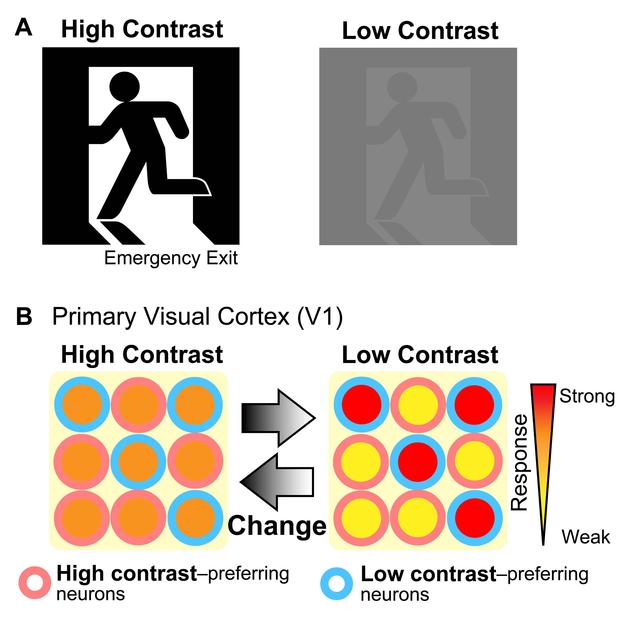Recent Research Results
How can our brain still perceive familiar objects even when they become indistinct?
November 27, 2021
We reveal a new flexible mechanism of information representation, changing in correlation with visual contrasts
The appearance of objects can often change. For example, in dim evenings or fog, the contrast of the objects decreases, making it difficult to distinguish them. However, after repeatedly encountering specific objects, the brain can identify them even if they become indistinct. The exact mechanism contributing to the perception of low-contrast familiar objects remains unknown.
In the primary visual cortex (V1), the area of the cerebral cortex dedicated to processing basic visual information, the visual responses have been considered to reflect directly the strength of external inputs. Thus, high-contrast visual stimuli elicit strong responses and vice versa.
In this study, we found that in rats, the number of V1 neurons preferentially responding to low-contrast stimuli increases after repeated experiences. In these neurons, low-contrast visual stimuli elicit stronger responses, and high-contrast stimuli elicit weaker responses. These low contrast–preferring neurons show a more evident activity when rats correctly perceive a low-contrast familiar object. It was first reported in Science Advances that low-contrast preference in V1 is strengthened in an experience-dependent manner to represent low-contrast visual information well. This mechanism may contribute to the perception of familiar objects, even when they are indistinct.
Summary
We explored the brain neuronal mechanism that allows the perception of familiar images even if they are indistinct. The number of neurons responding to low-contrast rather than high-contrast visual stimuli increased in rats performing a visual orientation discrimination task after repeated experiences. These neurons showed stronger activities in correct-choice than incorrect-choice trials. These neurons efficiently represented low-contrast orientations. Thus, the low-contrast preference in V1 activity may contribute to improved low-contrast visual discrimination.
This flexible information representation may enable a consistent perception of familiar objects with any contrast. The flexibility of our brain makes our sensation effective, although you may not be aware of it. An artificial neural network model may reproduce the human sensation by incorporating not only high contrast–preferring neurons, generally considered until now, but also low contrast–preferring neurons, the main focus of this research.
The contribution of low contrast–preferring neurons to information representation in the primary visual cortex after learning. Rie Kimura & Yumiko Yoshimura. Science Advances (2021); 7(48):eabj9976 DOI: 10.1126/sciadv.abj9976
